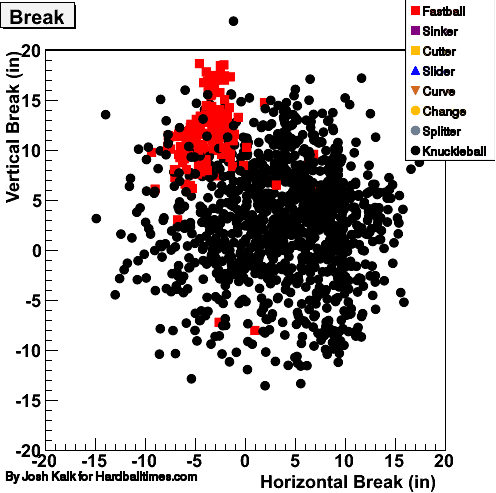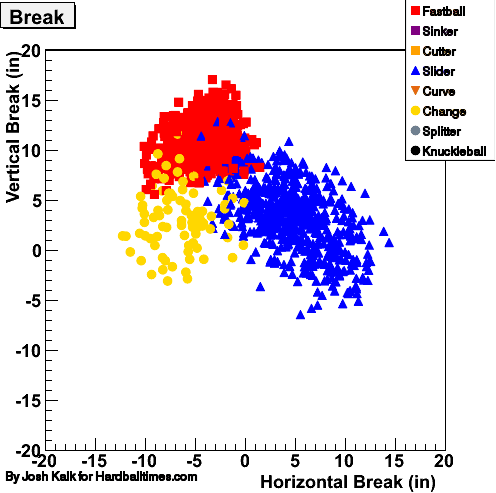The break on the knuckleball
MLB tracks every pitch thrown in a game using a system called PITCHf/x. You may have seen this system in action during televised games; it’s used to show the viewer where the pitch was located when it crossed the plate relative to the strike zone. On his baseball statistics blog, Josh Kalk takes these stats and lets you slice and dice them however you want.
One of the most interesting statistics measured is the break of a pitch…how much up-and-down and side-to-side motion a pitched ball goes through after leaving the pitcher’s hand. The break demonstrates why the knuckleball is such a difficult pitch to hit, particularly when used in conjunction with other pitch types. Here’s a graph showing the break on knuckleballer Tim Wakefield’s pitches so far this season:

The ball is all over the place…the hitter doesn’t know where it’s going. Compare that to the break on the three different pitches thrown by fellow Red Sox player Daisuke Matsuzaka:

Now take a look at the graphs on the player cards for Wakefield and Matsuzaka. Wakefield’s pitches also have a wider range of velocities…Matsuzaka’s pitches range in speed from about 77 to 95 mph while Wakefield’s pitches range from 65 to 95 mph. And the graphs don’t even account for the multiple breaks that a knuckleball can make during a single pitch. The uncertainties of speed and break of a knuckleballer’s pitches combine to create a lot of trouble for batters…they neither know where the ball’s going nor when it’s going to arrive. (thx, fred)
P.S. So why is Wakefield not as effective as many other major league pitchers (his career stats aren’t that impressive), none of whom throw the knuckleball? One guess is that sometimes the knuckleball doesn’t break and essentially becomes a 60-65 mph meatball right down the middle of the plate, a pitch any decent hitter can put anywhere he wants.
Update: I thought that Wakefield’s upper velocity range was a little high. I’m getting a lot of feedback saying that Wakefield’s fastball is in the low 80s, not the mid-90s. Looks like we’ve got some screwy data here.
Also, another reason why knuckleballers are of limited effectiveness: it’s difficult to throw a strike on command, which can be a problem when you’re behind in the count and you have to throw your 80 mph fastball for a strike. (thx, jonathan & steve)





Stay Connected